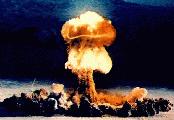






In March 1988, two years after the deal was struck, it was discovered that Saudi Arabia had bought an undisclosed number of CSS-2 "East Wind" intermediate range missiles from China. (1) The number was later put at 50 missiles and nine launchers. (2) According to Assistant Secretary of State Richard Clarke, the missiles were still not operational in late 1989. (3) However, in early June 1990, Flight International reported that, according to Israeli intelligence, the CSS-2 missiles were deployed and operational at two sites: al-Sulaiyil, about 500 km south of Riyadh and al-Joffer, 100 km south of Riyadh. According to the article, each site houses four to six concrete launch pads and stores approximately 60 missiles. (4)
The East Wind's modified range/payload (5) of 2,500 km/2,000 kg (conventional load) brings many countries within striking range, including Israel, the former Soviet Union, and Iran, though the missiles are said to be targeted on Tehran and other Iranian population centers, rather than Israel.The 2.5 km CEP of the CSS-2 missiles, combined with the cost of the purchase (6) has led to a great deal of speculation about Saudi Arabia's intentions. The missiles are far too inaccurate to be used against any point target with either HE or chemical warheads. King Fahd has pledged that Saudi Arabia will not arm the missiles with unconventional warheads nor use them in a first-strike mode. (7) According to a study by the Congressional Research Service, the Reagan administration received an assurance in writing that the Saudis would not obtain or use chemical or nuclear warheads with the CSS-2 missiles. (8) To further allay such fears, Saudi Arabia signed the NPT in April 1988. To date (August 1996), no ballistic missiles other than the CSS-2 are reported to be operational or under development in Saudi Arabia.
None of the CSS-2s was fired during Desert Storm. In an interview with The Washington Times, Saudi Prince Bandar bin Sultan, acknowledging the inaccuracy of the CSS-2 and its consequent potential for killing civilians, said, "King Fahd ruled out that option [launching the missiles against Iraq] because of the fact that you cannot conrol it [the missiles] accurately. Our problem is that our war was not with the Iraqi people; it was with Saddam Hussein and his clique." (9) However, the multi-billion dollar King Khalid Military City is reported to include nuclear missile silos and nuclear-proofed underground command bunkers with full arming and firing capabilities. (10)
1. According to the Los Angeles Times, the sale was made in July 1985 (Jim Mann, "U.S. caught napping by Sino-Soviet missile deal," Los Angeles Times, 4 May 88, p. 1, 8).
2. The Los Angeles Times reported (ibid., p. 8) that Saudi Arabia had purchased between 20 and 25 CSS-2 missiles, of which China is thought to have produced no more than 100. Two days later The Washington Times claimed, "The most recent shipment of about 25 CSS-2s arrived last month, complementing the first shipment of about 25 sent from China last fall." (Bill Gertz, "State, Pentagon worry about Saudi missiles," The Washington Times, 12 May 88, p. A3) These figures differ substanially from the later claim, discussed below, that the Saudis had deployed four to six launchers and 60 missiles at each of two sites.
3. David B. Ottaway, "U.S. Aide Opposes Halting Arms Sales Over Missiles," The Washington Post, 8 Nov 89, p. 37.
4. "Saudi CSS-2 missiles now operational," Flight International, 6-12 June 90, pp. 12-13.
5. The CSS-2 was designed for a nuclear warhead and, therefore, has low accuracy. The unmodified version has a range/ payload of 2,700 km/2,200 kg. (The Military Balance 1989-90, International Institute for Strategic Studies, p. 219).
6. The price for the missiles, training, and support is placed at $1 billion to 3.25 billion. (Sunday Times [London], 23 May 88; "East Wind missiles chill U.S. Saudi relations," The Independent, 2 May 88, p. 12).
7. "Saudis Warn Iran They May Use Chinese Missiles," The New York Times, 28 Apr 88, p. 1.
8. Robert Shuey, p. 64.
9. Bill Gertz, "Saudis withheld missile to spare civilians," The Washington Times, 10 June 91, p. A4.
10. Odran Muntz Walsh, "Saudi Arabia's military oasis," Jane's Defence Weekly, 25 May 91, pp. 878-881.
